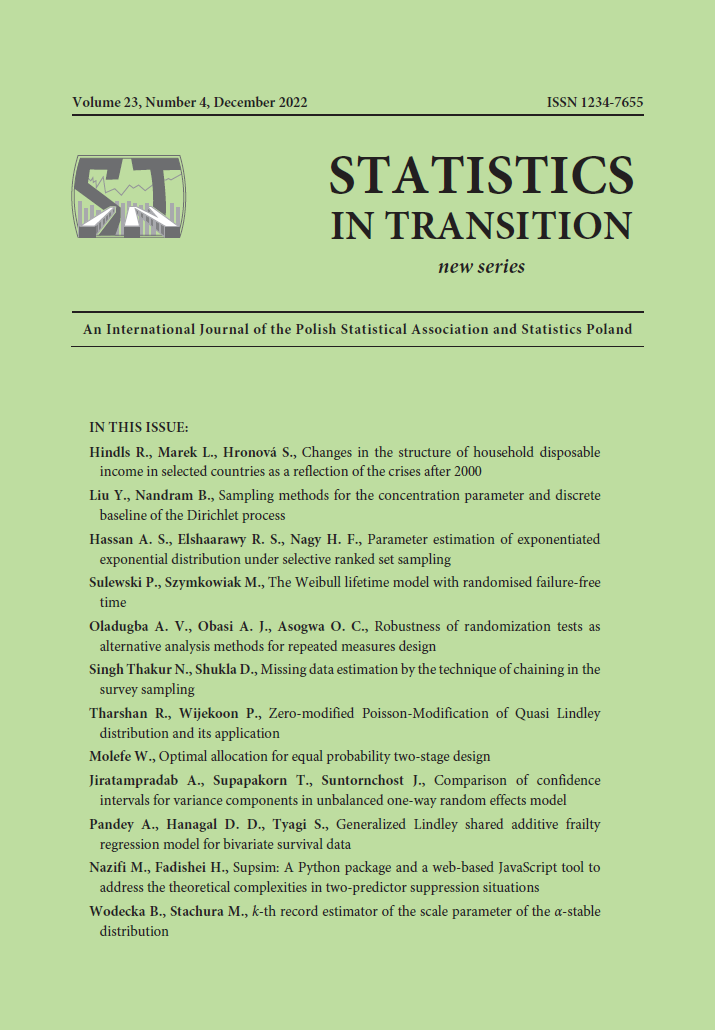ARTICLE
ABSTRACT
Various techniques of scale parameter estimation have been proposed in the case of alpha stable distributions. In the paper, the authors present an estimation technique that involves the k-th record theory. Although this theory is over 40 years old, its implementation in the classical extreme value theory – being the other cornerstone of the presented approach – is quite new, and tempting. Several theoretical properties of the introduced scale parameter estimators are presented. With the use of Monte Carlo methods, a comparative analysis is performed between the approach based on k-th records and approaches based on Hill’s and Pickands’ estimators. Additionally, the paper uses a real-life data set to illustrate how to effectively apply the k-th record estimator of the scale parameter. The research indicates several advantages of the k-th record approach over its other counterparts, especially when dealing with incomplete information about the underlying sample.
KEYWORDS
stable distribution, scale parameter estimator, k-th record values
REFERENCES
Aiube, F. L., Baidya T. K. N., Blank, F. F., Mattos, A. B., Saboia W. and Siddiqui, A. S., (2013). Modeling Hourly European Electricity Spot Prices via a SARMA-GARCH Approach. Working Paper of Stockholm University, (260041), pp. 1–46.
Ahsanullah, M., (1990). Estimation of the parameters of the Gumbel distribution based on the m record values. Comput. Statist. Quart, 6, pp. 231–239.
Berred, M., (1995). K-record values and the extreme-value index. J. Stat. Plan. Inference, 45, pp. 49–63.
Caeiro, F., Mateus, A., (2014). Randtests: Testing randomness in R. R package version 1.0, https://CRAN.R-project.org/package=randtests
Chrapek, M., (2012). Records: Record Values and Record Times. R package version 1.0, https://CRAN.R-project.org/package=Records.
Dziubdziela, W., Kopocinski, B., (1976), Limiting properties of the k-th record values. Zastosowania Matematyki, 15, pp. 187–190.
Faraway, J., Marsaglia, G., Marsaglia, J. and Baddeley, A., (2019). Goftest: Classical Goodness-of-Fit Tests for Univariate Distributions. R package version 1.2-2, https://CRAN.R-project.org/package=goftest
Gomes, M. I., E Castro, L. C., Fraga, Alves, M. I. and Pestana, D., (2008). Statistics of extremes for IID data and breakthroughs in the estimation of the extreme value index: Laurens de Haan leading contributions. Extremes, 11, pp. 3–34.
De Haan, L., Ferreira, A., (2006). Extreme Value Theory. An Introduction. Springer, New York.
Khindanova, I., Rachev, S. and Schwartz, E., (2001). Stable Modeling of Value at Risk. Mathematical and Computer Modelling, 34, pp. 1223–1259.
Meraghni, D., Necir, A., (2007). Estimating the Scale Parameter of a Lévy-stable Distribution via the Extreme Value Approach. Methodol Comput Appl Probab, 9(4), pp. 557–572.
Malinowska, I., Pawlas, P. and Szynal, D., (2005). Estimation of the parameters of Gumbel and Burr distributions in terms of kth record values. Applicationes Mathematicae, 32, pp. 375–393.
Malinowska, I., Szynal, D., (2004). On a family of Bayesian estimators and predictors for a Gumbel model based on the kth lower records. Applicationes Mathematicae, 31, pp. 107–115.
Nolan, J. P., (2011). Stable Distributions – Models for Heavy Tailed Data. Birkhäuser, Boston.
Pitman, E., (1937). The “closest” estimates of statistical parameters. Mathematical Proceedings of the Cambridge Philosophical Society, 33(2), pp. 212–222.
R Core Team, (2018). R: A language and environment for statistical computing. R Foundation for Statistical Computing, Vienna, Austria, URL https://www.Rproject. org/.
Samorodnitsky, G., Taqqu, M. S., (1994). Stable Non-Gaussian Random Processes: Stochastic Models with Infinite Variance, Chapman & Hall, New York.
Stachura, M., (2017). On improved estimation of the extreme value index with the use of a shifted Hill's estimator. Research Papers of the Wroclaw University of Economics, 482, pp. 252–260.
Stachura, M., Wodecka, B., (2016). Wybrane aspekty i zastosowania modeli zdarzeń ekstremalnych, Research Papers of the Wroclaw University of Economics, 427, pp. 205–214.
Stoyanov, S., Samorodnitsky, G. and Rachev, S. T., (2006). Computing the portfolio Conditional Value-at-Risk in the ?-stable case. Probability and Mathematical Statistics, 26(1), pp. 1–22.
Weron, R., (2001). Levy-stable distributions revisited: tail index > 2 does not exclude the Levy-stable regime. International Journal of Modern Physics C, 12 (2), pp. 209– 223.
Weron, R., (2004). Computationally intensive Value at Risk calculations, Papers, Humboldt-Universität Berlin, Center for Applied Statistics and Economics (CASE), No. 2004, 32.
Wodecka, B., (2016). Wybrane aspekty i zastosowania modeli zdarzeń ekstremalnych. Estymacja modeli na podstawie teorii wartości rekordowych, PhD Thesis, available at: http://hdl.handle.net/11089/20449.
Wuertz, D., Maechler, M. and Rmetrics Core Team Members, (2016). Stabledist: Stable Distribution Functions. R package version 0.7-1, https://CRAN.Rproject. org/package=stabledist.
Wuertz, D., Setz, T., Chalabi, Y., Boudt, C., Chausse, P. and Miklovac, M., (2020). fGarch: Rmetrics – Autoregressive Conditional Heteroskedastic Modelling. R package version 3042.83.2, https://CRAN.R-project.org/package=fGarch
